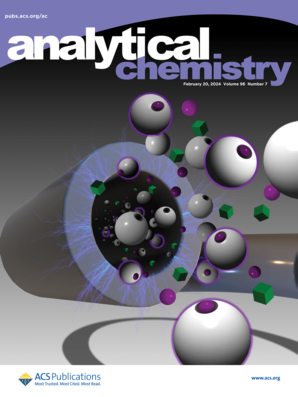一种ph敏感的近红外荧光探针在发现新的LC3配体促进attec构建中的作用。
IF 6.7
1区 化学
Q1 CHEMISTRY, ANALYTICAL
引用次数: 0
摘要
自噬系固化合物(Autophagy-tethering compounds, attec)作为一种新的靶向蛋白降解技术,可以直接将靶标与LC3(一种关键的自噬体相关蛋白)结合,随后通过自噬溶酶体途径导致靶标降解。在此,我们开发了一种新的LC3配体筛选策略,使用具有ph敏感和LC3靶向特征的近红外荧光探针。探针和潜在LC3配体的存在导致与细胞内LC3的竞争性结合,并阻碍探针通过自噬途径进入酸性溶酶体并被激活。值得注意的是,我们实验室的内部化合物LD5通过该策略被筛选出作为LC3的潜在配体,并通过SPR技术进一步验证了其与LC3的结合能力。以LD5作为LC3结合片段,合成了两个attec,分别具有显著的降解PCSK9和脂滴的活性,进一步验证了我们LC3配体筛选策略的可行性。本文章由计算机程序翻译,如有差异,请以英文原文为准。
A pH-Sensitive NIR Fluorescent Probe as a Protagonist in the Discovery of New LC3 Ligands Facilitating the Construction of ATTECs.
Autophagy-tethering compounds (ATTECs) as a new targeted protein degradation technology could directly bind targets to LC3 (a key autophagosome-associated protein) and subsequently result in the degradation of targets via the autophagolysosomal pathway. Herein, we developed a new LC3 ligand screening strategy using an NIR fluorescent probe with both pH-sensitive and LC3-targeted features. The presence of both the probe and a potential LC3 ligand leads to competitive binding to LC3 in cells and hinders the probe from entering and being activated in acidic lysosomes via the autophagy pathway. Notably, LD5, an in-house compound of our lab, was screened out as a potential LC3 ligand by the strategy, and its capacity of binding to LC3 was further verified by SPR technology. By using LD5 as the LC3 binding moiety, two ATTECs were synthesized, which exhibited significant activities in degrading PCSK9 and lipid droplets, respectively, and further validated the feasibility of our LC3 ligand screening strategy.
求助全文
通过发布文献求助,成功后即可免费获取论文全文。
去求助
来源期刊

Analytical Chemistry
化学-分析化学
CiteScore
12.10
自引率
12.20%
发文量
1949
审稿时长
1.4 months
期刊介绍:
Analytical Chemistry, a peer-reviewed research journal, focuses on disseminating new and original knowledge across all branches of analytical chemistry. Fundamental articles may explore general principles of chemical measurement science and need not directly address existing or potential analytical methodology. They can be entirely theoretical or report experimental results. Contributions may cover various phases of analytical operations, including sampling, bioanalysis, electrochemistry, mass spectrometry, microscale and nanoscale systems, environmental analysis, separations, spectroscopy, chemical reactions and selectivity, instrumentation, imaging, surface analysis, and data processing. Papers discussing known analytical methods should present a significant, original application of the method, a notable improvement, or results on an important analyte.
 求助内容:
求助内容: 应助结果提醒方式:
应助结果提醒方式:


